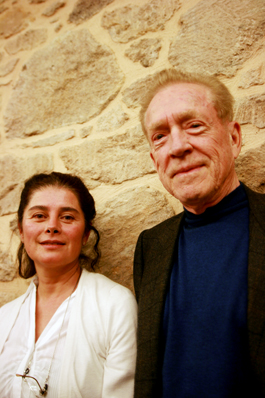home | north bay bohemian index | features | north bay | feature story

Photograph by Gabe Meline
GIVERS: William and Leticia Jarvis gain their greatest pleasures from educating and giving.
Life of Learning
The cultural-frontier couple behind the Jarvis Conservatory
By Gabe Meline
When William and Leticia Jarvis first visited the dilapidated Lisbon Winery at the corner of Yount and Main streets in Napa, the building was inhabited by two rival gangs. One group lived at one side of the building, one squatted at the other; the tense situation eventually escalated in a large fire that gutted most of the inside. "Which was fine," William Jarvis says mildly, walking among the elegant new interior the historic 125-year-old building hosts today. "We completely redid the inside anyway."
A stunning remodel turned the property into the Jarvis Conservatory, and the city of Napa was grateful that the gangs were gone and that an eyesore had been restored. We honor the Jarvis Conservatory for a different reason. For its ongoing Saturday Opera Night series, for its long commitment to bringing Spanish musical theater to life through 16 different presentations of zarzuelas, and for its recent art films series and numerous special performing arts events, the Jarvis Conservatory is long overdue as one of this year's Boho Award honorees.
On a recent evening, Jarvis sits in the office of the conservatory, dressed in a long-sleeved blue shirt and suit jacket. "In '95, there was a big void," he says. "There wasn't a lot of entertainment here at all. This was before the development of the Napa Valley Opera House, before COPIA came on the scene, before the Lincoln Theater. So there was a lot of interest at that time, but not a lot of way to carry it out."
Jarvis, who grew up in Oklahoma and "never went back," originally came to Napa with his wife to found Jarvis Winery. Yet in addition to bringing their passion for wine to the area, the couple held a longtime passion for opera, for dance, for the arts. Opening the conservatory was essential, he says, for his life's goal of constant study.
In its Saturday Opera Night series, which has been a feature every first Saturday of the month since the conservatory opened its doors, the Jarvis stage is open to opera singers from all around the Bay Area in a one-of-a-kind event that can only be described as opera open mic. From such a supportive breeding ground, many of the singers who began here have gone on to successful singing careers in New York and Germany. Most all of the former trainees come back to revisit the theater and sing again.
Now, with its art film series, the conservatory brings acclaimed independent films to Napa that would otherwise require an hour-long drive to see on the big screen. This night's offering is Louise Bourgeois, a documentary about the famed sculptor, and while William describes the thrill of meeting his wife more than 30 years ago, Leticia Jarvis rushes into the office to announce that the film is starting. The art film series, after all, is her baby—the sibling, if you will, to William's Saturday Opera Night.
The couple works well together, but what's especially touching is their tenderness. During the film, sitting together in the theater's private box, William and Leticia laugh together, with Leticia often leaning forward in her chair to touch William's shoulders, to whisper in his ear or to rest her cheek on his arm. Both of them gaze at the screen, learning about the techniques, the philosophies and the life of Bourgeois.
That's what the thrust of the Jarvis Conservatory boils down to: education. "We call this a 'conservatory,' because of the people who learn things here," says William. "Not only the singers, but the stagehands, the directors—all the people who learn here."
After 13 years at the Conservatory, the Jarvises foresee no slowing down. Currently, they're at work bringing an elaborate puppet show to their stage this November, an event that has proven popular with Latino families and something that fulfills the conservatory's commitment to bringing fine arts to a community that may not otherwise have access to or funds for live performances.
"The reason we came up with the concept of the conservatory," Leticia says, "was to give. We've been so lucky—I mean, we've worked very hard—but with all of what we've gotten from our work, it's a way of giving back some of what we have."
Send a letter to the editor about this story.
|
|
|
|
|
|